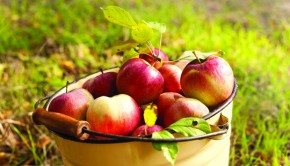An A for APPLES, It’s a Top-Ranked Superstar Fruit
Nutrient density—an acknowledged characteristic of apples—is considered the most significant qualification for a superfood. “It’s one of the healthiest foods,” advises Case Adams, from Morro Bay, California, a naturopathic doctor with a Ph.D. in natural health sciences. Apples’ antioxidant power alone could elevate it to status as a superior superfood. Eating apples could help ward off America’s most pressing yet preventable, chronic illnesses, which the U.S. Department of Health and Human Services cites as heart disease, diabetes and cancer.
Strategic Eating
Morwenna Given, a medical herbalist and Canadian member of the American Herbalists Guild, from Toronto, explains why and shares an analogy, “The normal metabolic processes of oxidation produce reactive oxygen species (free radicals) with unpaired electrons that hunt and steal partner electrons from the body’s cells. Imagine an electrical plug wherein the grounding wire has been eliminated or compromised. There is nothing to prevent a surge or fire.” This is comparable to what happens to a body impacted by a poor diet, lack of exercise, stress and illness; its healthy grounding is compromised.
When the overall damage to cell structure overwhelms the body’s innate antioxidation defenses, conditions are ripe for disease and accelerated aging. Foods high in antioxidants, like the apple, help to neutralize the damage and heal bodily tissues.
Flavonoids—like the quercetin just beneath the peel—are another of the apple’s powerful nutrient partners, notes Adams in his book, The Ancestors Diet. So, even when making applesauce, including the peel is vital. With the exception of vitamin C, all other nutrient compounds remain intact when the fruit is cooked.
Subtle differences in polyphenol levels exist among apple varieties, according to Linus Pauling Institute testing. Polyphenol compounds ultimately activate the fruit’s antioxidant and anti-inflammatory properties. Northern spy, Fuji and especially red delicious varieties are the richest in antioxidants; empire and golden delicious harbor relatively low levels.
“Some older varieties that had lost popularity with large-scale commercial farmers are now being grafted again, thanks to a return to organic practices,” remarks Meredith Hayes, schools and student nutrition senior manager at FoodShare, a leading North American food security organization.
Note that conventionally grown apples top the Environmental Working Group’s list of 48 fruits and vegetables tested for pesticide residue (ewg.org/foodnews/list.php). That’s yet another sound reason, along with better taste and nutrition, to go organic.
Good Genes
“The purpose of any seed is to replicate the species,” explains Given. “The pulp around the seed protects and feeds the seed until it’s burrowed into the soil and germinates. Older species evolved to be protective of their seeds to survive against pests and other insults. Commercially grown produce, however, has generally bred out the secondary metabolites that house so many of a plant’s nutrients.”
It helps to know that imperfect-looking food has potentially synthesized more sugars and nutrients in response to stress in order to survive, making blemishes or irregular shapes more appealing as consumers discover the core value of non-homogenized fruit.
In 2012, Hayes worked with Tom O’Neill, general manager of Canada’s Norfolk Fruit Growers Association, to repackage smaller “unacceptable” apples into an ideal bag weight and size for a second-grader to carry and share in school meal and snack programs. Previously, these “too-small” apples were being tilled back into soil or sold in Europe because there was no market for them here,” says Hayes. “So, we looked for ways to honor imperfect fruit.”
Other beneficial movements against food waste that are also making produce more affordable include France’s Intermarché supermarket’s popular inglorious fruits and vegetables campaign, with the tagline, “As good, but 30 percent cheaper,” and Portugal’s ugly fruit program. Such initiatives are raising happy awareness of so-called imperfect, and often organically grown, food.
By recognizing and appreciating the apple during this season’s harvest, we honor its versatility, affordability, broad availability and culinary flexibility.
Tania Melkonian is a certified nutritionist and healthy culinary arts educator in Southwest Florida. Connect at EATomology.com.
<










